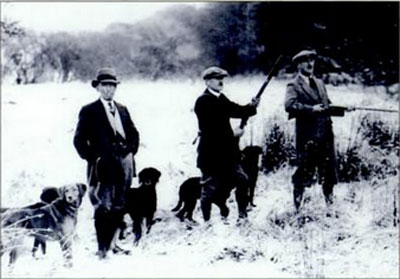Captain Forster Green Uprichard
Forster Green Uprichard was born on 27 June 1883 at Laurencetown House, Laurencetown, County Down, son of prominent linen maker Henry Albert Uprichard and his wife Emily Uprichard (nee Green).
His mother died soon after giving birth in 1887 and his father in 1903, leaving the business – the Springvale Bleach Works – to his sons William, Forster and Emile. (Emile then sold his share to his brothers.) Another brother, Henry Albert, became managing director of Belfast tea merchant Forster Green & Co.
Forster was commissioned as a 2nd lieutenant in the North Irish Horse on 9 August 1914 and embarked for France on 4 April 1915, where he was posted to C Squadron. In a letter published in the Belfast News-Letter on 8 June, Sergeant Richard Irwin wrote:
The fact is we could not be better officered than we are. Mr. F. G. Uprichard has joined us, so I think on the whole West Down is well represented.
Uprichard was promoted to lieutenant on 1 July 1915, and captain on 18 November.
The war diary of C Squadron mentions him a number of times:
No 4 Troop (Capt. Uprichard) proceeded to 24 Div H.Q. at Bailleul S 14 (sheet 28) to relieve Div. mtd. trps. (29 April 1916)
Capt F.G Uprichard, Lieut T.H.M Leader & 15 NCOs & men attached to 153rd & 143rd Brigades R.F.A. for a tour of the observation posts of 36th Div. Artillery Front. (18 May 1916)
Capt R.A.B Henry & party of NCOs & men relieved Captain F G Uprichard & party at 36th Div. observation posts. (21 May 1916)
Captain F G Uprichard & 25 NCOs & men relieved Capt. J. Grant & party at Martinsart. (27 May 1916)
Capt F.G. Uprichard & party of 25 NCOs & men returned from working duties at Martinsart. (3 June 1916)
In June 1916 C Squadron joined F Squadron of the North Irish Horse and the 6th (Inniskilling) Dragoons Service Squadron to form the 2nd North Irish Horse Regiment, serving as corps cavalry regiment to X Corps. Over the next year the regimental diary mentions Captain Uprichard a number of times, including when he was wounded by shellfire while leading a trench fatigue on the Somme front:
'C' Squadron found the day fatigue on battleground, there was some shelling Captain F.G. Uprichard being slightly wounded very early in the proceedings. (20 July 1916)
Capt Uprichard rejoined C Squadron on being relieved at Contay by Mr Vesey. (7 September 1916)
Captain F Uprichard started for Amiens on 7 day leave to Ireland W.P.A. (17 September 1916)
A Board consisting of Capts Dimes, Uprichard & Lieut Despard examined 5 candidates for certificates in cold shoeing. The five passed successfully. (7 October 1916)
Usual Digging party under Capt Uprichard. (11 November 1916)
Usual party for trench digging under Capt Uprichard. (12 December 1916)
Capt Uprichard was in charge of Working Party. (7 February 1917)
Capt Uprichard who was in charge of Trench party reported all quiet. (15 February 1917)
Usual Trench Digging Party under Capt Uprichard. (9 March 1917)
Usual digging party went up to the GHQ 2nd line trenches under Capt Uprichard who reported all quiet. (23 March 1917)
Capt F Uprichard rejoined from Road Control yesterday. (7 June 1917)

Larne Times and Weekly Telegraph, 26 August 1916
In September 1917 the 2nd North Irish Horse Regiment was dismounted and most of its officers and men transferred to the 9th Battalion, Royal Irish Fusiliers. Uprichard reported for duty with the battalion on 30 September, but left a fortnight later, having transferred to the 13th Battalion, Royal Irish Rifles (which a month later became the 11/13th Battalion).
During 1918 he transferred to the 15th Battalion, Royal Irish Rifles.
He was demobilised on 9 February 1918 and relinquished his commission on 1 April 1920.
After the war he returned to the family linen business. He died on 19 June 1945.
Captain Uprichard's brother, Major Henry Albert Uprichard, was killed in action on 1 July 1916 while serving with the 13th Battalion, The Royal Irish Rifles.

Captain Uprichard on the right

Uprichard (front row, second from right) at Ardnabannon with a family group.
Images and some of the informstion above sourced from Kathleen Rankin's The Linen Houses of the Bann Valley.
